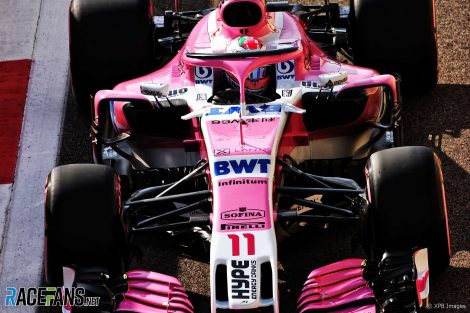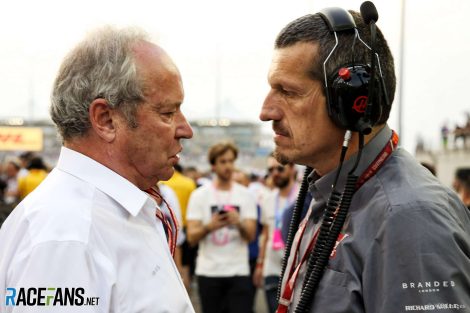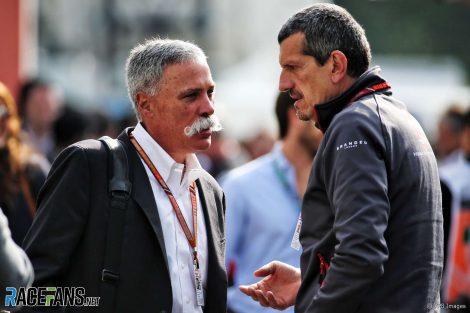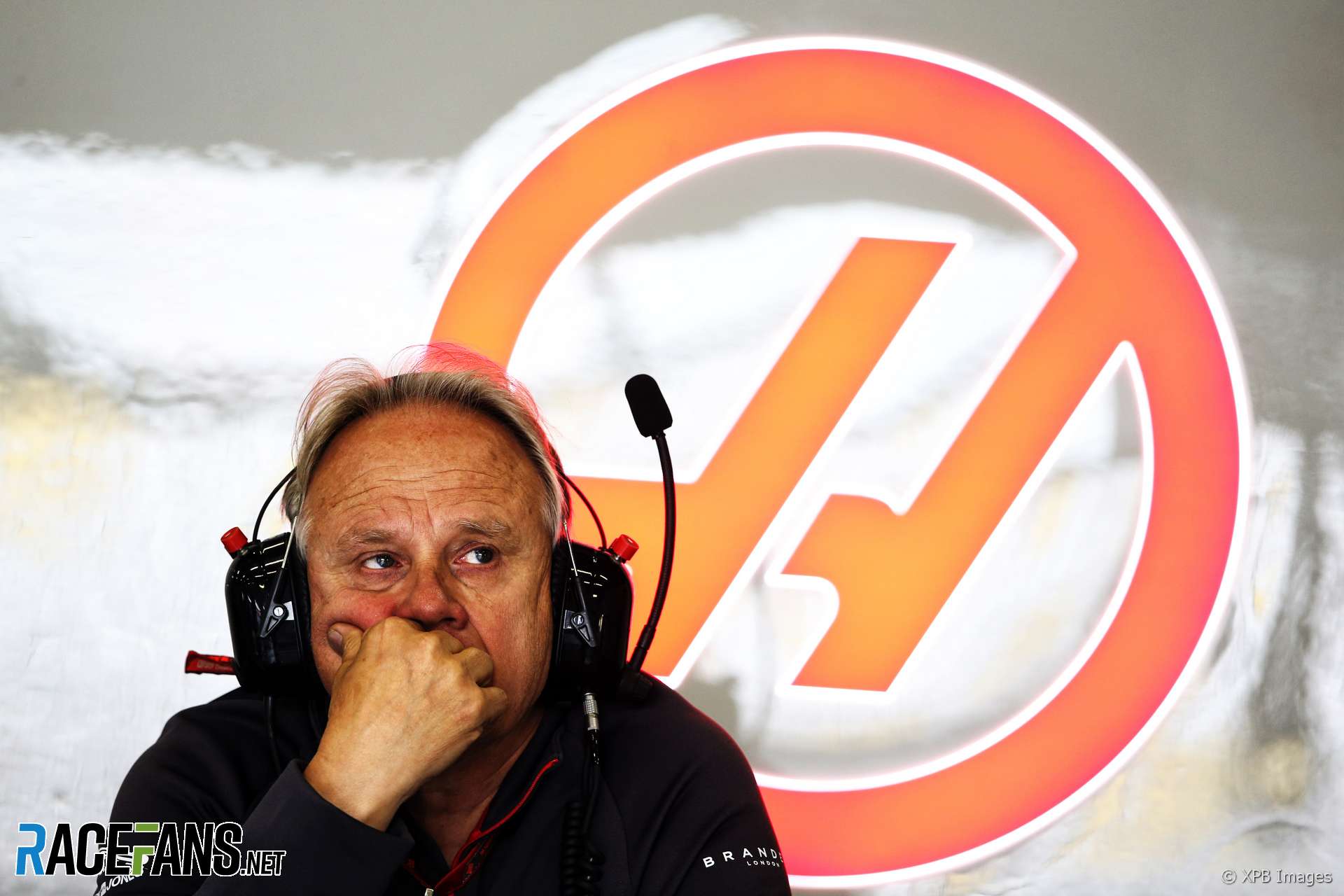If a single 2018 incident demonstrated just how disjointed Formula 1 has become, it was the Haas versus Force India protest filed late on Thursday in Abu Dhabi.
Significantly, the protest came within F1 hours of scrutineering and ahead of the season’s final championship round. Also crucial to proceedings is that Abu Dhabi steward Garry Connelly also officiated in Belgium, where Racing Point Force India was declared a new team holding a new entrant license. Thus there was no cause to postpone or reconvene the matter at a later date, enabling both the hearing and the crucial (and expected) outcome – namely that the Force India cars were legal – to be handed ahead of FP3 on Saturday.However, Force India’s victory actually represents a defeat as we outlined here immediately after verdict. The road map of the mess F1 found itself in has been detailed in these pages since Force India plunged into administration at end-July. But these are the symptoms, not the cause.
Consider the essence of the matter: In order to prove a (Liberty Media) commercial breach, Haas turned to FIA-appointed stewards to protest the eligibility of cars on sporting grounds. They disputed whether Force India held exclusive rights to its technology after plunging into an administration which was triggered by a driver’s unpaid 2017 wages.
Why this process? Because the “exclusive right” clause is demanded in the Sporting Regulations (appendix six) but detailed in a bilateral agreement entered into between Force India’s former owners and commercial rights holder Formula One Management, in turn owned by Liberty Media. All teams are party to such agreements with the commercial rights holder – the mere fact that these are not multi-lateral agreements tells its own story.

That they did so at all, let alone within that timeframe, bears testimony to their unique skills, but equally the matter illustrates just how convoluted – some say dysfunctional – F1’s governance process is. Unless that is rectified by 2021, when the bilaterals expire (see below), the entire sport risks a repeat, one with potentially costlier consequences, plus more egg on F1’s corporate face.
At the heart of the issue lies a multitude of contracts, covenants, agreements, amendments, regulations, codes and appendices. All of these have an impact on F1 by outlining the obligations of various players: the teams individually and collectively, the commercial rights holder FOM (now owned by Liberty Media, and not a party to some of the original signings) and the FIA. Yet, not a single player is a signatory to all documents!
Forget the hackneyed saying ‘the left hand not knowing what the right does’ – in this instance one F1 hand does not know another exists. Admittedly, relations are much-improved after Liberty acquired F1’s rights from venture vultures CVC Capital Partners (who one team boss accused of ‘raping’ the sport, and replaced F1-tsar Bernie Ecclestone with Chase Carey, but still…
The complexity of F1’s current structures is perfectly illustrated by this list of documents currently in force:
100-Year Agreement: Between FIA/FOM granting the latter F1’s exclusive rights for a century. This agreement originally ran for 10 years, but during a three-year rumble with the EU Commission, the Mosley-era FIA saw fit to extend it to 100 years to circumvent EU requirements, some of which would now greatly benefit the FIA. Thus the agreement was extended: 10 to 13 years, then by 100 years. It expires at the end of 2110.
Concorde Implementation Agreement: Entered into between FIA and FOM in July 2013, this document outlines the rights and obligations of the former and F1’s governance process for 1 January 2013 – 31 December 2020, given that the governing body is not party to the bilaterals (below). No teams are party to this document.
Bilateral agreements: Between FOM/teams individually, running from 1 January 2013 – 31 December 2020 and contain non-disclosure clauses. Resemblance between agreements is coincidental: Ferrari, Red Bull and McLaren’s include Strategy Group powers, but Ferrari’s includes long-standing bonuses the others don’t qualify for, while theirs provide for (varying) constructor championship bonuses.
Advert | Become a RaceFans supporter and
Mercedes deal is retrospectively the same as Red Bull. Williams holds a similar contract, but the (heritage) bonus is modest – thus the top five (at the time) contracts vary materially. Remaining contracts are basic, although Renault’s contains amendments offering similar deals to Mercedes subject to certain conditions, while Haas, as a later comer, holds a shorter contract. Force India’s was amended to pay the (disputed) Column One money. Thus the only teams to hold identical bilateral contracts are Toro Rosso and Sauber.
Technical Regulations: Running to 105 pages with all appendices, these are complied and updated annually, and administered by the FIA. Neither the teams nor Liberty are party to the final regulations, although the teams have input via the (non-executive) Technical Working Group, while the latter provides input (only) via a recently constituted technical department.
Sporting Regulations: Running to 70 pages with all appendices, these are complied and updated annually, and administered by the FIA. Neither the teams nor Liberty are party to the final regulations, although the teams have input via the (non-executive) Sporting Working Group, while the latter provides input (only) via a recently constituted sporting department.
FIA International Sporting Code: Consists of 80 pages for circuit events, plus 12 Appendices, the code is self-explanatory, and takes precedence over all regulations save where specified otherwise, as is the case with existing bilaterals…

The latter was entered into by six teams in the city of that name in July to provide for Force India’s monies to be paid should the team be sold as a going concern, i.e. with a continuation of the company registration number and then-current entrant license. Dissenters were McLaren, Renault and Williams, while Haas made clear it had signed on “a going concern sale” basis only.
After the sale fell through due to legal issues, the transaction was switched to an asset sale – with a new company acquiring the bankrupt team’s assets and racing under a new entrant license. Haas gave notice it was withdrawing its approval as the sale conditions had changed materially, but the other three signed.
Thereafter, Haas variously wrote to FOM voicing opposition to the (unfathomable) decision to view Racing Point Force India as a going concern and thus pay it $60m in historic revenues due to the old team. According to sources FOM initially did not respond, then provided only vague answers, which caused Haas to consider its (legal) options.
Even more unfathomable is that FOM viewed three different documents containing a total of nine signatures as unanimous agreement despite not having all signatories agreeing to the same clauses, yet (allegedly) took its (flawed) decision based on internal and external legal advice that it had unanimity…
Whatever, astute readers will note that one agreement is not mentioned above, namely the Concorde Agreement. This term is trotted out regularly by those – including team bosses, their senior executives, FOM and FIA personnel, and even the odd F1 journalist – who really should know better. The reason Concorde is not listed above is elementary: No agreement by that name is currently in force.
Why not? In its haste to list F1 and exit its most profitable (ever) investment with a massive pile of riches, CVC scrapped the only overarching covenant F1 ever had, one that pulled F1’s various elements – sporting, technical, commercial and governance – together, and clearly defined the obligations of the governing body, of the commercial rights holder, and of the teams collectively and individually.

There are folk who argue that the (Concorde) implementation agreement and bilaterals effectively replaced Concorde, but how can that be the case when every team is locked into separate provisions?
Is it any wonder, then, that teams protest sporting matters to pursue commercial interests; that teams have no clear guidelines that define a constructor; that commercial agreements state that new teams need to finish in the top ten for two years in three – with only ten teams entered – yet ‘new’ teams are suddenly ‘old’? That is how F1’s regulatory processes have become through vaguely written rules, elastically applied.
The fact is that for the 10 years CVC owned F1, it cared only about investor fund returns, and not an iota about the sport, and hence introduced the most expedient set of agreements F1 has been tied to in its 65-year existence. Liberty must do better, but the question is whether it really can, given its NASDAQ status, with investor days clearly taking precedence over track days.
Here’s a current example of F1’s dysfunctional structures: On Sunday evening I enquired as to how the sport’s masters could award a tyre tender calling for 18-inch rubber from 2021 given that no such technical regulation change had been approved by the Strategy Group or Formula 1 Commission.
I was told that as the current procedure – namely the Strategy Group to F1 Commission to World Motor Sport Council flow – expires with the bilaterals at end-2020, the ISC thus becomes the guiding code for post-2020 regulations, without provision for team input.
All fine and good, but any future regulatory process governance could well overrule incoming regulations, particularly if the teams are given a say, as they will no doubt demand. What then? Another tender? Already the existing tender proved flawed in that it expires in 2019, not the logical 2020 cut-off.
What thus needs is a long-term constitution that encompasses every single aspect of the sport, overseen by an independent individual with broad experience in all areas, in essence being the chairman of an advisory board that examines the consequences of all changes. Such advisory board run changes by all players to ensure that changes to Sporting Rule X don’t impact negatively on Technical Rule Y or Commercial Clause Z.
Advert | Become a RaceFans supporter and
Corporations have such processes, with proposals being passed through oversight committees prior to board approval. Concorde had similar provisions, with (executive) Working Groups submitting proposals to the F1 Commission, which escalated these to the WMSC for ratification, but no independent parties were involved in the flow, which was also flawed in that broadcasters – the sport’s biggest “customer” block – had no voice.

As the Haas versus Force India matter proved, F1’s processes have ever-widening cracks, and rather than paper over the walls as has been the sport’s wont for too long, Liberty needs to underpin the foundations and strengthen the structures of the house it bought at great cost from CVC rather than roll out floral wall paper. Clearly, the ultimate owner of the building, the FIA, needs to be involved, too, as in any lease agreement.
They have two years remaining to effect the “renovations”, and given the modest overall impact Liberty has had on F1 in the past two years, that is a big ask. During a recent investor call Carey stated: “We’re focused on a larger list of sporting regulation changes to further improve the sport for our drivers and fans.
“I am often asked about the so-called Concorde Agreement [note], we’re making progress regarding the broader set of changes to cost structures, revenue distribution regulations and governance. [We’ve had] constant constructive discussions with the teams, and at the end of the day, our interests are aligned.”
Let us hope for F1’s sake that really is the case, Chase.
The Force India-Haas dispute
- Stroll deal to bring Force India out of administration
- Haas has not agreed for Force India to receive prize money
- Why Force India’s rescue deal could still unravel
- Haas lodge protest against Force India
- Steiner says Haas is seeking “equal treatment” with its Force India protest
- Stewards dismiss Haas’s protest against Force India
- Why Haas’s ‘defeat’ in Force India protest was really a win
Follow Dieter on Twitter: @RacingLines
Go ad-free for just £1 per month
>> Find out more and sign up
RacingLines
- The year of sprints, ‘the show’ – and rising stock: A political review of the 2021 F1 season
- The problems of perception the FIA must address after the Abu Dhabi row
- Why the budget cap could be F1’s next battleground between Mercedes and Red Bull
- Todt defied expectations as president – now he plans to “disappear” from FIA
- Sir Frank Williams: A personal appreciation of a true racer





Phylyp (@phylyp)
28th November 2018, 12:32
Phew, that’s quite the article, another one that raises the bar! I’d want to read it another time around to get the finer nuances of it.
This has Brawn written all over it as the best suited candidate – he gets both the technical and political aspects of F1.
socksolid (@socksolid)
28th November 2018, 16:17
My first thought was ron dennis.
Joking!
BlackJackFan
28th November 2018, 17:09
Dieter – wonderfully comprehensive article…
Socksolid – this might not need to be as funny as you suggest… ;-)
Phylyp (@phylyp)
28th November 2018, 12:32
Minor point – I think there’s a link missing at the end of that sentence.
Nick Wyatt (@nickwyatt)
28th November 2018, 12:53
@dieterrencken An excellent guide to the chaos that is F1. I will be referring back to this one, I’m sure.
But here’s a question; do I remember you writing that Carey personally had a relatively short contract? If that’s the case, it would be tempting for him to kick the problems down the road, finish his contract, take the bonus and leave the mess for the next bloke.
Probably the best solution all round would be to scrap everything and rewrite all the rules and regs, codes and all the rest on a multi-lateral basis. But no one is going to agree to do that – least of all Liberty’s shareholders.
ColdFly (@)
28th November 2018, 13:59
If only I could bookmark this article for future reference.
erikje
28th November 2018, 16:45
;)
https://www.racefans.net/2018/11/28/haass-protest-was-a-legacy-of-f1s-missing-concorde-agreement/
mrfill
28th November 2018, 13:57
There’s a disturbing rumour circulating that CVC are interested in buying into motogp. Hoping to repeat their previous ‘success’ in the motorsport arena, presumably.
ColdFly (@)
28th November 2018, 14:07
As there is no Concorde Agreement in place, and commercial issues are regulated via bilaterals, then Haas has little chance of claiming any money back. Of course, unless the bilateral states that any new entrant after them will not be treated favourably (and define clearly what that means) versus how Haas has been treated.
But I doubt that any businessman or lawyer would ever allow such a clause in a commercial contract.
Jere (@jerejj)
28th November 2018, 14:17
”It expires at the end of 2110.” – LOL. That’s forever from now.
Phylyp (@phylyp)
28th November 2018, 14:45
@jerejj – we might think that, but Bernie’ll still be around with his pitchfork then.
Jere (@jerejj)
28th November 2018, 15:01
@phylyp Indeed, LOL.
Flip
28th November 2018, 14:28
This, as all your work, was brilliant. I’m happy you wrote this all down and will save it for re-reading because it’s such a tangle of strings.
Also, I didn’t comment on your last Paddock Diary, but they are immensely enjoyable, hope they continue in 2019 and beyond.
Cheers
Trayambak Chakravarty (@major-dev)
28th November 2018, 16:38
I’ll be honest, it usually takes me something like three readings to understand completely what Dieter has to say, but these articles are academic-level in their intensity and research. Kudos to you for the effort!
bernasaurus (@bernasaurus)
28th November 2018, 17:25
Wonderful Dieter, thank you.
And CVC are still up to the usual;
https://www.theguardian.com/sport/2018/nov/27/premiership-clubs-likely-to-agree-200m-deal-sell-stake-cvc-rugby-union
rpaco
28th November 2018, 17:51
There is an old Pink Floyd song called “Set the controls for the heart of the sun” (Early one, Sid’s era) that’s what Bernie had done before he abandoned the F1 vessel.
By the time the escape pod was ready, the the FTL engines were shot, navigation unreliable, and fuel on last knockings, F1 was not sustainable. When Liberty were welcomed aboard and given the suckers tour, they did not get to see everything, much duct tape and baling wire was hidden along with the Gordian knots of agreements and contracts. They were conned into paying more than zero, (Which is roughly what it was worth at the time, if you count debts as liability and not assets) they did not believe so many systems were malfunctioning, they thought that they knew sports and the big American way would win everybody over. Well they should have spoken to people who had bought things from Bernie before! We here all know that F1 is different to everything else, it is clear that Liberty thought they knew better, I am not at all sure that even now they realise how far different it is. Still currently heading for the heart of the sun!
What startles me is the humble? dumb? servile? manner in which the FIA appears to have handed F1 over to Liberty in its entirety. Liberty should only be involved in the commercial side, the FIA is the rule maker it is not the commercial rights lease holder. Yet Ross is going round spouting about changing the format, the regs, everything! Is the FIA planning to abdicate responsibility altogether? Is this the reason for the FIA setting up a duplicate organisation in Switzerland? Will it solely become Jean Todt’s road safety organisation? Concorde House a mail box only?
falken (@falken)
28th November 2018, 22:50
Claims of there still being a Concorde. Comments?
https://twitter.com/FormulaMoney/status/1067898270524022784
Jimmi Cynic (@jimmi-cynic)
29th November 2018, 2:11
That document is a ‘Concorde’ between the FIA and FOM FOAM CVC, that is assigned to Liberty. Not a global agreement between the former and any of the teams.
It’s not the Concorde agreement between Bernie and the teams as we have historically referred to it. Which when it existed (allegedly) prior to 2013 was a mythical document shrouded in mystery and speculation.
Dieter Rencken (@dieterrencken)
29th November 2018, 11:27
Thank you Jimmi – you’re totally correct. If anything that tweet proves my point: the twittering tweeter clearly doesn’t understand the difference between the words “means” and “is”.
So lest he reads this – which I take as a compliment as I refuse to read his stuff anywhere lest I be misinformed, and only became aware of the tweet via Falken’s post above – here are the dictionary definitions of the words:
Means: Intend to convey or refer to (a particular thing); signify
Is: the third-person singular present tense of the English language verb “to be”
Clearly there is a difference, and the filing intends to convey that a Concorde Agreement exists, when in fact it does not – only the Concorde Implementation Agreement “is”, and that is covered not only in my feature above, but in the filing extract in the tweet.
My contention, and the thrust of my article, is that no overarching agreement currently exists in F1 – and the filing proves that to the case – not that I needed it proving. Seems someone, somewhere, got suckered by semantics…
Incidentally, the stewards published a long list of documents that had been submitted in evidence in Abu Dhabi by the various parties:
Appendix A
Date Document
15 March 2012 Team Agreement between Force India and FOWC and SLEC
Holdings Ltd.
July 2018 Budapest Agreement
August 2018 FIA Draft Deed of Release and Wavier
21 August 2018 Racing Point Force India FIA Entry Form and Associated
Documentation
23 August 2018 Letter from Jean Todt to Force India Formula One Team Ltd.
23 August 2018 Bilateral Settlement Agreement
27 August 2018 Email from Charlie Whiting to Andrew Green
1 November 2018 Deed of Novation and Amendment between FOWC, SLEC Holdings
Ltd., Force India Formula One Team Ltd (in administration), the
Administrators, Racing Point Ltd. and Racing Point UK Ltd.
8 November 2018 Letter from Ebury Partnership to FIA and FOWC
12 November 2018 Letter from Bird & Bird on behalf of the FIA to Ebury Partnership
15 November 2018 Letter from Ebury Partnership to Bird & Bird
21 November 2018 Letter from Bird & Bird to Ebury Partnership
22 November 2018 Email from Pierre Ketterer to Garry Connelly
22 November 2018 Haas F1 Team Protest of Car No. 11
22 November 2018 Haas F1 Team Protest of Car No. 31
23 November 2018 Skeleton Argument of Racing Point UK Ltd
Is it not strange that no Concorde Agreement is listed, but the bilateral between Force India and FOWC/SLEC is. Also note that the FIA not a signatory to that bilateral.
Dieter Rencken (@dieterrencken)
1st December 2018, 11:19
More: that twittering tweeter has now tweeted about FWONK share price plunging due to ‘perception of uncertainty due to lack of Concorde Agreement’. Not only did I cover that topic here in RaceFans almost a month ago, but it totally contracts his earlier outburst about a Concorde Agreement currently existing. As I said, someone had been suckered by semantics…
Nitzo (@webtel)
29th November 2018, 6:41
I always get to know a lot from Dieter’s articles…including this one.
Today, this article made me read a little bit further and i realized how naive i still am–Lehmann Brothers once owned a stake in Formula 1 !!
Aleš Norský (@gpfacts)
29th November 2018, 17:20
Look at the bright side @dieterrencken…all this provides you with solid job security at least until the end of 2110!